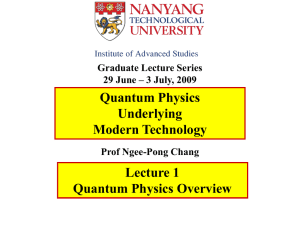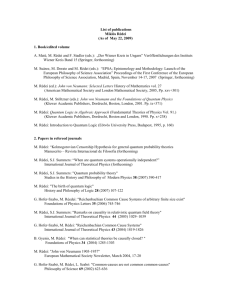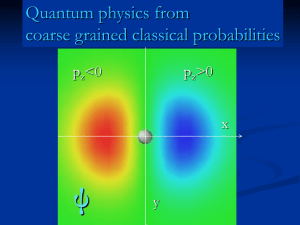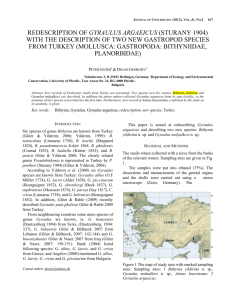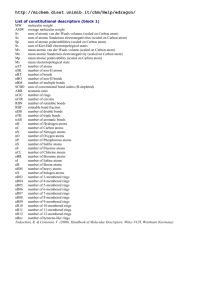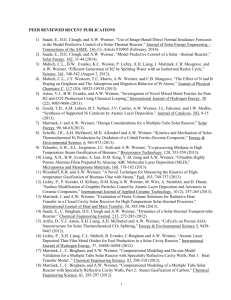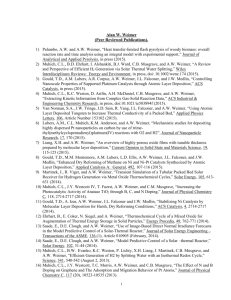Caesium beam clock - qoqi.physik.uni
advertisement
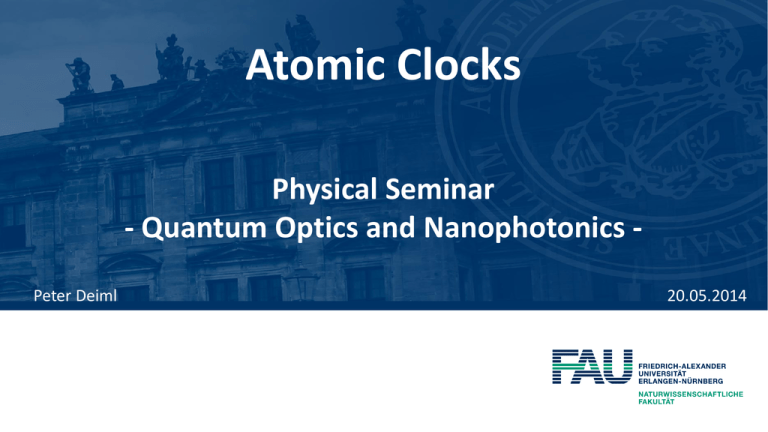
Atomic Clocks Physical Seminar - Quantum Optics and Nanophotonics Peter Deiml 20.05.2014 Table of contents • Why do we need an exact definition of time? • Current time standard • Spectroscopy • Ramsey-Spectroscopy • Caesium beam clock • (Laser Cooling) • Caesium fountain clock • Outlook: Optical Clock Quantum Optics and Nanophotonics Atomic Clocks Peter Deiml 2 Why do we need an exact definition of time? [Bauch, 2003],[Bauch, 2012] “The accurate measurement of time and frequency is vital to the success of many fields of science and technology.” [Bauch, 2003] Some scientific examples: Some everyday examples: • Other SI-units (e.g. meter) • Global Positioning System based upon the second (GPS) • Spectrum of atoms (QM,QED) • Telecommunication • „Proof“ of equivalence • Supply of energy principle, SR, GR (Hafele-Keating-/ Maryland-experiment) • Gravitational waves • Fine structure constant Fig. 2: NAVSTAR satellite [Wiki GPS, 2014] Fig. 1: Hafele, Keating & stewardess aboard airplane with two atomic clocks [Wiki HKE, 2014] constant? Quantum Optics and Nanophotonics Atomic Clocks Peter Deiml 3 Current time standard Definition of the second (1967) „The second is the duration of 9192631770 periods of the radiation corresponding to the transition between the two hyperfine levels of the ground state of the caesium 133 atom“ [BIPD, 2006] • Why atomic properties? • Why the Cs-133 atom? • Why hyperfine levels? • Why exactly 9192631770 periods of the radiation? → value equals to ephimerises second Quantum Optics and Nanophotonics Fig. 3: Solar system with sun and the nine planets (not true to scale) [SeaSky, 2014] Atomic Clocks Peter Deiml 4 Current time standard Why atomic properties? [Bauch, 2012] „ Zeit [ist] die Stellung des kleinen Zeigers meiner Uhr “ [Einstein, 1905] • Every frame of reference has its own time • Atomic properties determined by natural constants (in rest frame of the atom) Fig. 4: Spacetime in special relativity Time determined by natural constants! Quantum Optics and Nanophotonics [Wiki SR, 2014] Atomic Clocks Peter Deiml 5 Current time standard Why the Cs-133 atom? [PTB] • Small thermal velocity due to large mass (later: Doppler effect → 0) • Technology for measuring the resonance frequency was available in 1967 • The only natural isotope of caesium • Only two hyperfine levels in the ground state • Transition has small natural line width • Small boiling point (670°C) Quantum Optics and Nanophotonics Atomic Clocks Peter Deiml 6 Current time standard Why hyperfine levels? [Audoin et al., 2005] Quantum number configuration of the outermost electron of Cs-133: • No fine structure (J) • Transition for time standard: F = 3 ↔ F = 4 Fig. 6: Cutting of the hyperfine structure of Cs-133 [Bauch, 2003] Quantum Optics and Nanophotonics Atomic Clocks Peter Deiml 7 Spectroscopy General idea Investigation of the answer of atoms or molecules to a laserbeam Perfect method for measurement of the second Examples: • Information about structure of stars Fig. 7: UVES on the very large telescope on Cerro Paranal (Chile) • Scientific applications: medicine (MRT), [Wiki SpC, 2014] [Wiki SpC, 2014] chemistry, biology Quantum Optics and Nanophotonics Fig. 8: Dispersion of white light by a prism Atomic Clocks Peter Deiml 8 Spectroscopy Broadening mechanisms [Meschede, 2007] Natural line width: Fig. 9: spectrum of low-pressure mecury bulb [Wiki NLW, 2014] Doppler effect: Fig. 10: Gauß-Voigt profile with underlying natural line width [Meschede, 2007] Quantum Optics and Nanophotonics Atomic Clocks Peter Deiml 9 Spectroscopy Broadening mechanisms [Meschede, 2007] Time-of-flight (TOF) broadening [Meschede, 2007] Fig. 11: Scheme of spectroscopy experiment [Wiki TOF, 2014] Other broadening mechanisms [Audoin et al., 2006] Quantum Optics and Nanophotonics Atomic Clocks Peter Deiml 10 Ramsey-Spectroscopy Young‘s double slit (Position space): Fig. 12: Scheme of Young‘s double slit [Wiki YDS, 2014] Quantum Optics and Nanophotonics Fig. 13: Distribution of intensity [Wiki YDS,2014] Atomic Clocks Peter Deiml 11 Ramsey-Spectroscopy Fig. 15: See frame 11 Fig. 14: Scheme of Ramsey-spectroscopy Quantum Optics and Nanophotonics Atomic Clocks Peter Deiml 12 Caesium beam clock Caesium beam tube [Bauch, 2003],[Audoin et al., 2006] • Analyzer deflects F = 4 atoms towards detector Fig. 16: Scheme of the magnetically deflected caesium beam tube [Bauch, 2003] Quantum Optics and Nanophotonics Atomic Clocks Peter Deiml 13 Caesium beam clock The CS2 clock at the Physikalisch Technische Bundesanstalt (PTB) Fig. 18: See frame 13 Fig. 17 : Vertical section of the vacuum chamber of PTB‘s primary clock CS2 [Bauch, 2003] Quantum Optics and Nanophotonics Atomic Clocks Peter Deiml 14 Caesium beam clock Function of Polarizer/Analyzer [Audoin et al., 2006] Fig. 19: Energy of the hyperfine levels via the magentic flux density [Audoin et al., 2006] Quantum Optics and Nanophotonics Atomic Clocks Peter Deiml 15 Caesium beam clock C field inside the cavity [Riehle, 2004] Fig. 20: See frame 12 Quantum Optics and Nanophotonics Atomic Clocks Peter Deiml 16 Caesium beam clock Frequency response of a caesium beam tube [Audoin et al., 2006] Fig. 21: Scheme of the resonance of the central part [Bauch, 2003] Quantum Optics and Nanophotonics Atomic Clocks Peter Deiml 17 Caesium beam clock Frequency response of a caesium beam tube [Audoin et al., 2006] Fig. 22: See frame 17 Quantum Optics and Nanophotonics Atomic Clocks Peter Deiml 18 Laser cooling [Weyers et al., 1999] Fig. 23: Order of laser beams, their polarisation in an optical molasse Fig. 24: Order of laser beams, their polarisation in a magneto-optical trap [Weyers et al., 1999] [Weyers et al., 1999] Quantum Optics and Nanophotonics Atomic Clocks Peter Deiml 19 Caesium fountain clock General structure [Weyers et al., 1999] • Charge of magneto-optical trap • State-selection, Ramsey cavity and C-field analogeously to caesium beam clock • Difference: Preparation of F = 4 atoms • Only one interaction zone is needed • Different detection method with lasers Fig. 25: Simplified setup of the atomic fountain clock [Wynands et al., 2005] Quantum Optics and Nanophotonics Atomic Clocks Peter Deiml 20 Caesium fountain clocks Results of caesium fountain clock [Weyers et al., 1999] Figure 21 (CSF1): Fountain clocks more precise than beam clocks Quantum Optics and Nanophotonics Atomic Clocks Peter Deiml 21 Outlook Optical clocks Fig. 27: Temporal development of frequency uncertainty [Udem et al.,2009] Optical clocks need the frequency comb technology Quantum Optics and Nanophotonics Atomic Clocks Peter Deiml 22 Take-home message Current time standard: • Exact definition is needed Caesium beam/fountain clock: • Definition of the second & its justification • General setup • Functional principle and task of all components Spectroscopy: • Method for realization of time standard • Broadening mechanisms • Frequency response signal • Fountain clock more precise than beam clock Ramsey-Spectroscopy: Optical clocks: • Double slit in time space • More precise than caesium clocks • Strong analogy to Young‘s double slit in • Frequency comb technology is nessecary position space Quantum Optics and Nanophotonics Atomic Clocks Peter Deiml 23 Hallo Thank you for your attention and feel free to ask questions! (after the next presentation ) Quantum Optics and Nanophotonics Atomic Clocks Peter Deiml 24 Appendix Detection and measurement of transition [Weyers et al., 1999] • Measurement of flourescence by two detectors (photodiodes) Fig. 20: Scheme of the detection zone [Weyers et al., 1999] Quantum Optics and Nanophotonics Atomic Clocks Peter Deiml 25 References [Audoin et al., 2006] [PTB 1] Audoin C., Guinot B., The measurement of time, Cambridge University Press, 2001 Bauch A., Caesium Atomic Clocks: Function, Performance and Applications, Measurement Science and Technology 14, 1159-1173 (2003) Bauch A., Zeitmessung in der PTB, PTB Mitteilungen 122, 2012 Bauch A., Fischer B., Heindorff T., Schröder R., Performance of the PTB reconstructed primary clock CS1 and an estimate of ist current uncertainty, Metrologia 35, 829-845, 1998 Bureau international des poids et mesures, Organisation interfouvernementale de la Convention du Mètre. Le Système international d‘unités, 8e édtion, 2006 Demtröder, W., Experimentalphysik 3, Atome, Moleküle und Festkörper, 3. Auflage, Springer Verlag, Berlin, Heidelberg, New York, 2005 Einstein A., Zur Elektrodynamik bewegter Körper, Annalen der Physik und Chemie. 17, S. 891 – 921, 1905 Fließbach T., Allgemeine Relativitätstheorie, Spektrum, 2006 Meschede D., Optics, Light and Lasers, Wiley-VCH Verlag GmbH & Co. KGaA, Weinheim, 2007 Physikalisch-Technische Bundesanstalt, Wie funktioniert eine Atomuhr? [PTB 2] Physikalisch-Technische Bundesanstalt, Optische Atomuhren [Bauch, 2003 ] [Bauch, 2012] [Bauch et al., 1998] [BIPD, 2006] [Demtröder, 2005] [Einstein, 1905] [Fließbach, 2006] [Meschede, 2007] Quantum Optics and Nanophotonics Atomic Clocks Peter Deiml 26 References [Riehle, 2004] [Udem et al., 2009] [Weyers et al., 1999] [Wynands et al., 2005] Riehle F. Frequency Standards: Basics and Applications, Wiley-VCH Verlag GmbH & Co. KGaA, Weinheim, 2006 Udem T., Holzwarth R., Hänsch T. W., Femtosecond optical frequency combs, European Journal of Physics – Special Topis 172,69-79, 2009 Weyers S., Griebsch D., Hübner U., Schröder R., Tamm C., Bauch A., Die neue Caesiumfontäne der PTB, PTB-Mitteilungen 109, 483-491, 1999 Wynands R., Weyers S., Atomic fountain clocks, Metrologia 42, 64-79, 2005 Quantum Optics and Nanophotonics Atomic Clocks Peter Deiml 27 Web references [Wiki SR, 2014] http://en.wikipedia.org/wiki/Special_relativity, 02.05.2014 [Wiki GPS, 2014] http://de.wikipedia.org/wiki/Global_Positioning_System, 02.05.2014 [Wiki SC, 2014] http://de.wikipedia.org/wiki/Bahnhofsuhr, 02.05.2014 [Wiki MBD, 2014] http://en.wikipedia.org/wiki/Maxwell%E2%80%93Boltzmann_distribution, 02.05.2014 [Wiki SpC, 2014] http://en.wikipedia.org/wiki/Spectroscopy, 02.05.2014 [Wiki NLW, 2014] http://de.wikipedia.org/wiki/Linienbreite, 02.05.2014 [Wiki TOF, 2014] http://de.wikipedia.org/wiki/Flugzeitverbreiterung, 02.05.2014 [Wiki YDS, 2014] http://de.wikipedia.org/wiki/Doppelspaltexperiment, 09.05.2014 [SeaSky, 2014] http://www.seasky.org/solar-system/solar-system.html, 18.05.2014 [Spiegel, 2013] http://www.spiegel.de/wissenschaft/technik/zeitmessung-physiker-bauen-zuverlaessigste-uhraller-zeiten-a-917409.html, 18.05.2014 Quantum Optics and Nanophotonics Atomic Clocks Peter Deiml 28
